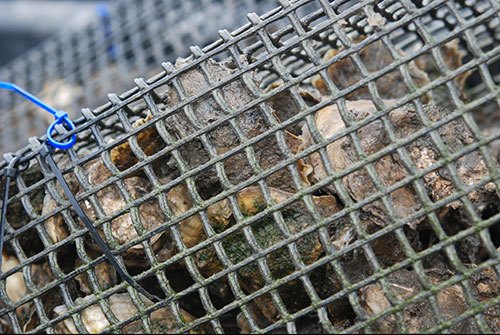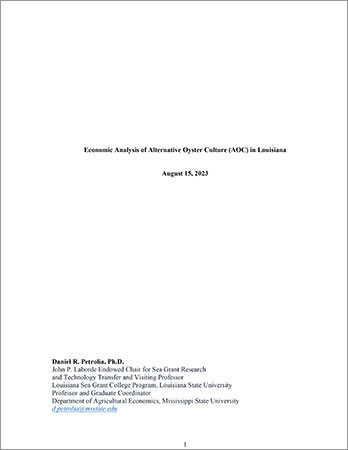AOC Economics Study Finds Scale and Marketing Challenges

In 2022, the State of Louisiana initiated an industry grants program to subsidize the development of Alternative Oyster Culture (AOC) businesses. The AOC method is relatively new to Louisiana and differs substantially from traditional, reef-based oyster production. AOC involves the use of hatchery-spawned oysters grown in containers. This method has been promoted as a way to help the state’s oyster industry adapt to coastal change – especially the impacts of large-scale river diversions.
In January 2023, Louisiana Sea Grant commissioned Daniel Petrolia to conduct an economic analysis of the AOC sector, and to assess its feasibility in terms of existing and future economic capacity. The results of Petrolia’s study, available at www.laseagrant.org/wp-content/uploads/AOC-Econ-Report-Petrolia-Aug15-2023-Final.pdf , indicate a number of challenges – especially in the areas of production scale (farm size) and market potential.
“I suspected going in that the costs of AOC would be considerably higher than that of reef oysters – but I was surprised to see just how much higher,” said Petrolia. Total cost, including loan payments, labor, fuel and oyster seed, is estimated to range from $50,000 a year to operate a small, half-acre farm to $250,000 a year to operate a large, four-acre farm.
Petrolia estimates that a small farm would need to sell oysters at more than $2 each to break even, a two-acre farm would need 71 cents apiece to break even and a four-acre farm would need a little over 50 cents apiece. “Based on what I was seeing in other states, it appeared that farms need to go big to be profitable over the long-haul. My findings confirm that,” he said.
The report estimates that average annual profit would be negative for farms of two acres or smaller. Petrolia reiterates that his findings are indicative of the average case, and that some farms may indeed be able to make it work at a smaller scale.
Beyond the farm level, however, Petrolia’s analysis points to larger concerns when it comes to marketing. The economist believes that’s where the bigger challenge lies ahead: “An AOC oyster must be marketed differently than a reef oyster, and currently there’s only so much local and regional demand for the branded half-shell market,” he said. Petrolia estimates that there are 10-15 establishments in south Louisiana and the Mississippi coast that feature branded, AOC-type half-shell oysters on their menus. Although some growers are getting $1 apiece, the average price in other states is between 40 to 59 cents. And in other states, some of these oysters are being sold in traditional markets at even lower prices. And, as mentioned earlier, to survive at these prices, farms will likely need to get bigger.
Asked about future prospects for AOC sector growth, Petrolia remains cautious: “Even under the most optimistic assumptions of where AOC production can be in the future, AOC is unlikely to account for more than a very small fraction of total oyster production in the state.” He added: “As an oyster mitigation strategy, there might be a need to consider other options.”
In the coming year, the current AOC sector, which includes 18 farms, will receive individualized access to the analysis. Using a spreadsheet-based tool developed by Petrolia, Louisiana Sea Grant’s Marine Extension Program (MEP) specialists and agents will be able to work one-on-one with AOC growers to analyze their own operations.
A presentation of the report can be viewed at https://youtu.be/GN-Ya1e9X-8.

